Enabling Technologies for Sector Coupling: A Review on the Role of Heat Pumps and Thermal Energy Storage
Abstract
:1. Introduction
2. What Is Sector Coupling?
3. Thermal Grids: General Aspects
4. The Heat Pumps for Power-Thermal End-Use Sector Coupling
4.1. Generalities
- Supplying ancillary services for the grid (grid-driven); Heat pumps are employed in a grid to ensure that voltage remains within allowed limits [44]. Excessive load causes a decrease in voltage and vice versa. The voltage level often increases during daytime when electricity is being injected into the grid through solar PV. During times of over-voltage, the active power demand of heat pumps can be increased to keep the voltage within the allowed range while decreasing it during the low-voltage time period. Heat pumps also help in congestion management by reducing grid reinforcement, keeping the transformer load in pre-determined tolerance ranges [45,46] through a switch on/off of heat pumps pools. Finally, HPs act as demand-side management units and can be used for responsive loads during times of imbalances in the grid [47,48]. For such reserves, a mechanism has been developed in the electricity market, which helps in deciding which units to use. In most countries, a minimum limit has been set to participate in the reserve market (e.g., 5 MW in Germany and 10 MW in northern European countries). So, a pool of heat pumps is needed in order to take part in a reserve market. Such projects have been mentioned in the references [49,50,51]; however, on-field examples are limited and need deeper understanding [44,52];
- Enabling integration of power through RES at building, grid, or power system level (renewable energy-driven); As far as wind power is concerned, it was shown that it can be integrated with variable speed heat pumps at the building level and the required electricity from the grid can be reduced up to 95% [53,54]. At grid level, as wind power plants are installed with a capacity of over 1 MW, a large number of HP would be needed to use the generated electricity. It has been shown that such a pool of HP, being controlled in an optimal way, helps in absorbing the electricity generated from wind power and thus assists in reducing the need for peak capacity [43]. Hedegaard and Münster studied the influence of heat pumps in reducing the need for peak capacity investments of 300–600 MW, corresponding to the size of a large powerplant [30]. They concluded that the integration of HP in large wind power systems can facilitate in reducing system costs, fuel consumption, and carbon emissions. They also mentioned that HP, along with individual heat storage, contributes significantly to peak load shaving. For optimal operation of heat pumps, an external signal is required containing electricity prices or real-time wind power production, which helps in adjusting the operation of heat pumps. Another effect of a wide deployment of heat pumps is linked to the fact that, for the last few years, locally generated PV electricity has become cheaper, thus going toward decentralized generation. In this view, the main advantage of heat pumps is the possibility to fully adapt to a demand-response approach if combined with real-time information. For instance, PV generation, upon exceeding a threshold, can switch on the heat pump’s operation, thus increasing the use ratio of locally produced electricity from 30% to over 65% [55]. Finally, with the help of heat pumps, reduction in feed-in peaks in the grid are reported in the range of 30–55% [56,57];
- Operating under fluctuating electricity prices (price-driven); One of the features that make the electrification of the heating and cooling sector interesting from an economic point of view is that energy costs can be saved by taking advantage of low prices in the day-ahead market and additional revenues can be earned in the balancing market [58]. Indeed, electricity prices keep fluctuating on day to day basis (day-ahead pricing) or even throughout a day (real-time pricing). A predictive model or a scheduling algorithm is needed that considers the load profile and electricity prices in order to guarantee a smooth and cost-efficient operation of heat pumps. Different price schemes were applied in studies that included prices of electricity that remain static for a long time [59,60,61,62] or fluctuate after short intervals [31,63,64,65]. The aim is to minimize the annual cost of energy. Most studies focused on decentralized control and reported significant load shifting using price signals. Moreover, savings were reported ranging from 7% up to around 35% [66,67]. Studies were carried out on how to control the working of HP when electricity prices are known ahead of time. Having such a schedule of electricity prices leads toward the operation of HP during night time, since prices are low at that period of time. It should be noted that the operation of an HP at variable times based on ‘reducing cost of energy’ may cause a decrease in its efficiency. The reduction in efficiency can be mainly because of higher storage temperature, lower external temperatures during operation, and enhanced part-load ratios [43].
4.2. Application of Heat Pumps in DHC
4.3. Heat Pumps as Enabling Technology for Sector Coupling
- Heat source;
- Heat pump technology, i.e., the connection, sizing, and operating mode of the heat pump;
- Heating demand, which is linked to the need for a demand-response approach.
5. Thermal Energy Storage for Power-Thermal End-Use Sector Coupling
5.1. Application of TES in DHC
- Coping up with heat load variations due to demand side: DHC systems often face heat load variations that result in increased cost for heat/cold generation and an increase in greenhouse gas emissions because of use of fossil fuel use associated with the use of boilers as generators for peak load. In order to cope with heat load variations, thermal energy storage can smooth the peak heat loads;
- Coping up with variations in the generation side: which are mainly due to variable renewable energy sources, such as solar. As the penetration of renewables in the heating sector has increased in the past decade, the incorporation of thermal storage with the heating sector is crucial [99]. Moreover, different RESs have different time scales for variation (i.e., seasonal or daily) and therefore require different types of TES;
- Increasing flexibility of system: Integration of thermal energy storage with district heating increases the flexibility of the system. Flexibility in terms of district heating can be defined as the capacity to shift the energy supply in terms of time, temperature levels, and power levels [100];
- Less infrastructure for DHC: Connecting TES to DHC networks allows for the use of a shorter pipe size for the distribution network [101]. When TES is installed on the primary line, it helps in overcoming the issues related to mass flow circulation. Water can be circulated at lower flow rates, which allow for smaller pipe size, thus reducing the associated pumping costs;
- Energy savings and reduction in greenhouse gases: the application of TES systems in buildings, industry, and DHC systems not only provide an annual energy saving but also helps in reducing CO2 emissions [102].
5.2. TES Technologies for DHC
5.3. TES as Enabling Technology for Sector Coupling
- CAES and PHES technologies lead to significant losses, and roundtrip efficiencies are 65% and 85%, respectively [5]. TES, on the other hand, minimizes roundtrip conversion losses;
- TES leads to higher efficiencies when RES are integrated as compared to electric storage [5];
- The lifetime and capacity of TES systems are also higher than the other two technologies mentioned [135].
6. Conclusions
Author Contributions
Funding
Institutional Review Board Statement
Informed Consent Statement
Data Availability Statement
Acknowledgments
Conflicts of Interest
Nomenclature
| ATES | Aquifer thermal energy storage |
| BTES | Borehole thermal energy storage |
| BITES | Building inertia thermal energy storage |
| COP | Coefficient of performance |
| CHP | Combined heat and power |
| CAES | Compressed air energy storage |
| DH | District heating |
| DHC | District heating and cooling |
| DHN | District heating network |
| DHW | Domestic hot water |
| EU | European union |
| GHG | Greenhouse gases |
| HP | Heat pumps |
| HWT | Hot water tank |
| IEA | International Energy Agency |
| LTES | Latent thermal energy storage |
| LTS | Long-term storage |
| MCES | Multi-carrier energy system |
| PCM | Phase change materials |
| PV | Photovoltaic |
| PTES | Pit thermal energy storage |
| PHES | Pumped hydro energy storage |
| RES | Renewable energy resources |
| STS | Short-term storage |
| TES | Thermal energy storage |
| TCMS | Thermochemical storage |
| TRL | Technology readiness level |
References
- Electricity Mix—Our World in Data. Available online: https://ourworldindata.org/electricity-mix (accessed on 15 June 2021).
- Kirkerud, J.G.; Bolkesjø, T.F.; Trømborg, E. Power-to-heat as a flexibility measure for integration of renewable energy. Energy 2017, 128, 776–784. [Google Scholar] [CrossRef]
- International Energy Agency. Statistics Report Key World Energy Statistics 2020; Springer: Berlin/Heidelberg, Germany, 2020. [Google Scholar]
- Jambagi, A.; Kramer, M.; Cheng, V. Electricity and Heat Sector Coupling for Domestic Energy Systems Benefits of Integrated Energy System Modelling. In Proceedings of the 2015 International Conference on Smart Cities and Green ICT Systems (SMARTGREENS), Lisbon, Portugal, 20–22 May 2015. [Google Scholar]
- Mathiesen, B.V.; Lund, H.; Connolly, D.; Wenzel, H.; Ostergaard, P.A.; Möller, B.; Nielsen, S.; Ridjan, I.; KarnOe, P.; Sperling, K.; et al. Smart Energy Systems for coherent 100% renewable energy and transport solutions. Appl. Energy 2015, 145, 139–154. [Google Scholar] [CrossRef]
- Van Nuffel, L.; Gorenstein Dedecca, J.; Smit, T.; Rademaekers, K. Sector Coupling: How Can it be Enhanced in the EU to Foster Grid Stability and Decarbonise; European Parliament: Brussels, Belgium, 2018. [Google Scholar]
- Münster, M.; Sneum, D.M.; Bramstoft, R.; Bühler, F. Sector Coupling: Concepts, State-of-the-art and Perspectives Low Carbon London View Project Design and Optimization of Flexible Multi-Generation Systems View Project. Available online: https://www.researchgate.net/publication/339365854 (accessed on 12 July 2021).
- Arabzadeh, V.; Mikkola, J.; Jasiūnas, J.; Lund, P.D. Deep decarbonization of urban energy systems through renewable energy and sector-coupling flexibility strategies. J. Environ. Manage. 2020, 260, 110090. [Google Scholar] [CrossRef] [PubMed]
- European Commission. The European Green Deal; European Commission: Brussels, Belgium, 2019. [Google Scholar]
- Eveloy, V.; Ayou, D.S. Sustainable district cooling systems: Status, challenges, and future opportunities, with emphasis on cooling-dominated regions. Energies 2019, 12, 235. [Google Scholar] [CrossRef] [Green Version]
- Paiho, S.; Saastamoinen, H.; Hakkarainen, E.; Similä, L.; Pasonen, R.; Ikäheimo, J.; Rämä, M.; Tuovinen, M.; Horsmanheimo, S. Increasing flexibility of Finnish energy systems—A review of potential technologies and means. Sustain. Cities Soc. 2018, 43, 509–523. [Google Scholar] [CrossRef]
- Perez-Mora, N.; Bava, F.; Andersen, M.; Bales, C.; Lennermo, G.; Nielsen, C.; Furbo, S.; Martínez-Moll, V. Solar district heating and cooling: A review. Int. J. Energy Res. 2018, 42, 1419–1441. [Google Scholar] [CrossRef]
- Guelpa, E.; Verda, V. Thermal energy storage in district heating and cooling systems: A review. Appl. Energy 2019, 252, 113474. [Google Scholar] [CrossRef]
- Buffa, S.; Cozzini, M.; D’Antoni, M.; Baratieri, M.; Fedrizzi, R. 5th generation district heating and cooling systems: A review of existing cases in Europe. Renew. Sustain. Energy Rev. 2019, 104, 504–522. [Google Scholar] [CrossRef]
- Enescu, D.; Chicco, G.; Porumb, R.; Seritan, G. Thermal energy storage for grid applications: Current status and emerging trends. Energies 2020, 13, 340. [Google Scholar] [CrossRef] [Green Version]
- Shabanpour-Haghighi, A.; Seifi, A.R. Effects of district heating networks on optimal energy flow of multi-carrier systems. Renew. Sustain. Energy Rev. 2016, 59, 379–387. [Google Scholar] [CrossRef]
- Mirzaei, M.A.; Nazari-Heris, M.; Zare, K.; Mohammadi-Ivatloo, B.; Marzband, M.; Asadi, S.; Anvari-Moghaddam, A. Evaluating the impact of multi-carrier energy storage systems in optimal operation of integrated electricity, gas and district heating networks. Appl. Therm. Eng. 2020, 176, 115413. [Google Scholar] [CrossRef]
- Geidl, M.; Andersson, G. Optimal power flow of multiple energy carriers. IEEE Trans. Power Syst. 2007, 22, 145–155. [Google Scholar] [CrossRef]
- Krause, T.; Andersson, G.; Fröhlich, K.; Vaccaro, A. Multiple-Energy Carriers: Modeling of Production, Delivery, and Consumption. Proc. IEEE 2010, 99, 15–27. [Google Scholar] [CrossRef]
- Favre-Perrod, P. A vision of future energy networks. In Proceedings of the IEEE Power Engineering Society Inaugural Conference and Exposition in Africa, Durban, South Africa, 11–15 July 2005. [Google Scholar]
- European Commission. Final—Powering a Climate-Neutral Economy: An EU Strategy for Energy System Integration; European Commission: Brussels, Belgium, 2020. [Google Scholar]
- Guelpa, E.; Bischi, A.; Verda, V.; Chertkov, M.; Lund, H. Towards future infrastructures for sustainable multi-energy systems: A review. Energy 2019, 184, 2–21. [Google Scholar] [CrossRef]
- Levihn, F. CHP and heat pumps to balance renewable power production: Lessons from the district heating network in Stockholm. Energy 2017, 137, 670–678. [Google Scholar] [CrossRef]
- Grohnheit, P.E. Modelling CHP within a national power system. Energy Policy 1993, 21, 418–429. [Google Scholar] [CrossRef]
- Kavvadias, K.; Jimenez Navarro, J.P.; Quoilin, A.; Navarro, J. Case Study on the Impact of Cogeneration and Thermal Storage on the Flexibility of the Power System; European Commission: Brussels, Belgium, 2017; ISBN 9789279778087. [Google Scholar]
- Jimenez-Navarro, J.P.; Kavvadias, K.; Filippidou, F.; Pavičević, M.; Quoilin, S. Coupling the heating and power sectors: The role of centralised combined heat and power plants and district heat in a European decarbonised power system. Appl. Energy 2020, 270, 115134. [Google Scholar] [CrossRef]
- Perez-Arriaga, I.J.; Batlle, C. Impacts of intermittent renewables on electricity generation system operation. Econ. Energy Environ. Policy 2012, 1, 3–17. [Google Scholar] [CrossRef] [Green Version]
- Lew, D.; Brinkman, G.; Ibanez, E.; Florita, A.; Heaney, M.; Hodge, B.-M.; Hummon, M.; Stark, G.; King, N.J.; Lefton, R.S.A.; et al. The Western Wind and Solar Integration Study Phase 2; NREL (National Renewable Energy Laboratory): Golden, CO, USA, 2013; Available online: http://www.osti.gov/bridge (accessed on 25 January 2021).
- Böttger, D.; Götz, M.; Lehr, N.; Kondziella, H.; Bruckner, T. Potential of the Power-to-Heat technology in district heating grids in Germany. Energy Procedia 2014, 46, 246–253. [Google Scholar] [CrossRef] [Green Version]
- Hedegaard, K.; Münster, M. Influence of individual heat pumps on wind power integration—Energy system investments and operation. Energy Convers. Manag. 2013, 75, 673–684. [Google Scholar] [CrossRef] [Green Version]
- Papaefthymiou, G.; Hasche, B.; Nabe, C. Potential of heat pumps for demand side management and wind power integration in the German electricity market. IEEE Trans. Sustain. Energy 2012, 3, 636–642. [Google Scholar] [CrossRef]
- Schaber, K.; Steinke, F.; Hamacher, T. Managing Temporary Oversupply from Renewables Efficiently: Electricity Storage Versus Energy Sector Coupling in Germany. In Proceedings of the 32nd Edition of the International Energy Workshop (IEW), Paris, France, 19–21 June 2013. [Google Scholar]
- Kiviluoma, J.; Meibom, P. Influence of wind power, plug-in electric vehicles, and heat storages on power system investments. Energy 2010, 35, 1244–1255. [Google Scholar] [CrossRef]
- Bloess, A.; Schill, W.P.; Zerrahn, A. Power-to-heat for renewable energy integration: A review of technologies, modeling approaches, and flexibility potentials. Appl. Energy 2018, 212, 1611–1626. [Google Scholar] [CrossRef]
- Heinen, S.; Burke, D.; O’Malley, M. Electricity, gas, heat integration via residential hybrid heating technologies—An investment model assessment. Energy 2016, 109, 906–919. [Google Scholar] [CrossRef]
- Werner, S. District Heating and Cooling. In Reference Module in Earth Systems and Environmental Sciences; Elsevier: Amsterdam, The Netherlands, 2013; Available online: https://www.diva-portal.org/smash/record.jsf?pid=diva2:676931 (accessed on 9 March 2021).
- Margolis, A. Experiences with district heating in Europe and USA and its further development. J. Inst. Heat. Vent. Eng. 1935, 3, 361–413. [Google Scholar]
- Brownlie, D. District heating in the United States and Russia. Engineering 1941, 152, 183–185. [Google Scholar]
- Lund, H.; Werner, S.; Wiltshire, R.; Svendsen, S.; Thorsen, J.E.; Hvelplund, F.; Mathiesen, B.V. 4th Generation District Heating (4GDH). Integrating smart thermal grids into future sustainable energy systems. Energy 2014, 68, 1–11. [Google Scholar] [CrossRef]
- Ma, Z.; Knotzer, A.; Billanes, J.D.; Jørgensen, B.N. A literature review of energy flexibility in district heating with a survey of the stakeholders’ participation. Renew. Sustain. Energy Rev. 2020, 123, 109750. [Google Scholar] [CrossRef]
- González Juncà, A.; Rius Carrasco, A.; Riba Ruiz, J.-R. Environmental Engineering Combined Heat and Power Generation Systems for Optimum Environmental and Economic Performance: A Case Study in Catalonia. Ph.D. Thesis, Universitat Politècnica de Catalunya, Barcelona, Spain, 2016. [Google Scholar]
- Mazhar, A.R.; Liu, S.; Shukla, A. A state of art review on the district heating systems. Renew. Sustain. Energy Rev. 2018, 96, 420–439. [Google Scholar] [CrossRef]
- Fischer, D.; Madani, H. On heat pumps in smart grids: A review. Renew. Sustain. Energy Rev. 2017, 70, 342–357. [Google Scholar] [CrossRef] [Green Version]
- Kinjyo, Y.; Palmer, M.D.; Yona, A.; Senjyu, T. Autonomous power system control by decentralized controllable loads. In Proceedings of the International Conference on Power Electronics and Drive Systems, Kitakyushu, Japan, 22–25 April 2013; pp. 881–886. [Google Scholar]
- Brunner, M.; Tenbohlen, S.; Braun, M. Heat pumps as important contributors to local demand-side management. In Proceedings of the 2013 IEEE Grenoble Conference, Grenoble, France, 16–20 June 2013. [Google Scholar]
- Bhattarai, B.P.; Bak-Jensen, B.; Pillai, J.R.; Maier, M. Demand flexibility from residential heat pump. In Proceedings of the IEEE Power and Energy Society General Meeting, National Harbor, MD, USA, 27–31 July 2014. [Google Scholar]
- Wang, D.; Parkinson, S.; Miao, W.; Jia, H.; Crawford, C.; Djilali, N. Hierarchical market integration of responsive loads as spinning reserve. Appl. Energy 2013, 104, 229–238. [Google Scholar] [CrossRef]
- Kirby, B.J. Spinning Reserve from Responsive Loads; Oak Ridge National Laboratory: Oak Ridge, TN, USA, 2003; Available online: https://info.ornl.gov/sites/publications/Files/Pub57288.pdf (accessed on 9 January 2021).
- Siano, P. Demand response and smart grids—A survey. Renew. Sustain. Energy Rev. 2014, 30, 461–478. [Google Scholar] [CrossRef]
- Shariatzadeh, F.; Mandal, P.; Srivastava, A.K. Demand response for sustainable energy systems: A review, application and implementation strategy. Renew. Sustain. Energy Rev. 2015, 45, 343–350. [Google Scholar] [CrossRef]
- Lund, P.D.; Lindgren, J.; Mikkola, J.; Salpakari, J. Review of energy system flexibility measures to enable high levels of variable renewable electricity. Renew. Sustain. Energy Rev. 2015, 45, 785–807. [Google Scholar] [CrossRef] [Green Version]
- Biegel, B.; Andersen, P.; Stoustrup, J.; Madsen, M.B.; Hansen, L.H. Lumped thermal household model. In Proceedings of the 2013 4th IEEE/PES Innovative Smart Grid Technologies Europe, ISGT Europe 2013, Aalborg, Denmark, 7–9 October 2013. [Google Scholar]
- Poulet, P.; Outbib, R. Energy production for dwellings by using hybrid systems based on heat pump variable input power. Appl. Energy 2015, 147, 413–429. [Google Scholar] [CrossRef]
- Hong, J.; Johnstone, C.; Torriti, J.; Leach, M. Discrete demand side control performance under dynamic building simulation: A heat pump application. Renew. Energy 2012, 39, 85–95. [Google Scholar] [CrossRef] [Green Version]
- Williams, C.J.C.; Binder, J.O.; Kelm, T. Demand side management through heat pumps, thermal storage and battery storage to increase local self-consumption and grid compatibility of PV systems. In Proceedings of the 2012 3rd IEEE PES Innovative Smart Grid Technologies Europe (ISGT Europe), Berlin, Germany, 14–17 October 2012. [Google Scholar]
- Dar, U.I.; Sartori, I.; Georges, L.; Novakovic, V. Advanced control of heat pumps for improved flexibility of Net-ZEB towards the grid. Energy Build. 2014, 69, 74–84. [Google Scholar] [CrossRef]
- De Coninck, R.; Baetens, R.; Verbruggen, B.; Driesen, J.; Saelens, D.; Helsen, L. Modelling and simulation of a grid connected photovoltaic heat pump system with thermal energy storage using Modelica. In Proceedings of the 8th International Conference on Computational Methods in Systems Biology, Trento, Italy, 29 September–1 October 2010; p. 177. [Google Scholar]
- Terreros, O.; Spreitzhofer, J.; Basciotti, D.; Schmidt, R.R.; Esterl, T.; Pober, M.; Kerschbaumer, M.; Ziegler, M. Electricity market options for heat pumps in rural district heating networks in Austria. Energy 2020, 196, 116875. [Google Scholar] [CrossRef]
- Arteconi, A.; Hewitt, N.J.; Polonara, F. Domestic demand-side management (DSM): Role of heat pumps and thermal energy storage (TES) systems. Appl. Therm. Eng. 2013, 51, 155–165. [Google Scholar] [CrossRef]
- Andreas, M. Adaptive Modellbasierte Prädiktive Regelung Einer Kleinwärmepumpenanlage; ETH Zürich: Zürich, Switzerland, 2006. [Google Scholar] [CrossRef]
- Sichilalu, S.; Mathaba, T.; Xia, X. Optimal control of a wind–PV-hybrid powered heat pump water heater. Appl. Energy 2017, 185, 1173–1184. [Google Scholar] [CrossRef] [Green Version]
- Wilfried, R. Regelung einer Wärmepumpenanlage mit Model Predictive Control; ETH Zürich: Zürich, Switzerland, 2004. [Google Scholar] [CrossRef]
- Salpakari, J.; Lund, P. Optimal and rule-based control strategies for energy flexibility in buildings with PV. Appl. Energy 2016, 161, 425–436. [Google Scholar] [CrossRef] [Green Version]
- Pedersen, T.S.; Andersen, P.; Nielsen, K.M. Central control of heat pumps for smart grid purposes tested on single family houses. In Proceedings of the 2013 10th IEEE International Conference on Networking, Sensing and Control (ICNSC), Evry, France, 10–12 April 2013; pp. 118–123. [Google Scholar]
- Vrettos, E.; Lai, K.; Oldewurtel, F.; Andersson, G. Predictive Control of buildings for Demand Response with dynamic day-ahead and real-time prices. In Proceedings of the 2013 European Control Conference (ECC), Zürich, Switzerland, 17–19 July 2013; pp. 2527–2534. [Google Scholar]
- Halvgaard, R.; Poulsen, N.K.; Madsen, H.; Jørgensen, J.B. Economic Model Predictive Control for building climate control in a Smart Grid. In Proceedings of the 2012 IEEE PES Innovative Smart Grid Technologies (ISGT), Washington, DC, USA, 16–20 January 2012. [Google Scholar]
- Kajgaard, M.U.; Mogensen, J.; Wittendorff, A.; Veress, A.T.; Biegel, B. Model predictive control of domestic heat pump. In Proceedings of the Proceedings of the American Control Conference, Washington, DC, USA, 17–19 June 2013; pp. 2013–2018. [Google Scholar]
- Hirst, E.; Kirby, B. Electric-Power Ancillary Services; Oak Ridge National Laboratory: Oak Ridge, TN, USA, 1996. [Google Scholar]
- Jóos, G.; Ooi, B.T.; McGillis, D.; Galiana, F.D.; Marceau, R. The potential of distributed generation to provide ancillary services. In Proceedings of the 2000 Power Engineering Society Summer Meeting (Cat. No.00CH37134), Seattle, WA, USA, 16–20 July 2000; Volume 3, pp. 1762–1767. [Google Scholar]
- Dallmer-Zerbe, K.; Fischer, D.; Biener, W.; Wille-Haussmann, B.; Wittwer, C. Droop controlled operation of heat pumps on clustered distribution grids with high PV penetration. In Proceedings of the 2016 IEEE International Energy Conference (ENERGYCON), Leuven, Belgium, 4–8 April 2016. [Google Scholar]
- Tanaka, K.; Yoza, A.; Ogimi, K.; Yona, A.; Senjyu, T.; Funabashi, T.; Kim, C.H. Optimal operation of DC smart house system by controllable loads based on smart grid topology. Renew. Energy 2012, 39, 132–139. [Google Scholar] [CrossRef]
- Heat Pumps in District Heating and Cooling Systems—Final Report—HPT—Heat Pumping Technologies. Available online: https://heatpumpingtechnologies.org/publications/heat-pumps-in-district-heating-and-cooling-systems-final-report/ (accessed on 14 January 2021).
- Chen, X.; Lu, X.; McElroy, M.B.; Nielsen, C.P.; Kang, C. Synergies of wind power and electrified space heating: Case study for Beijing. Environ. Sci. Technol. 2014, 48, 2016–2024. [Google Scholar] [CrossRef]
- Waite, M.; Modi, V. Potential for increased wind-generated electricity utilization using heat pumps in urban areas. Appl. Energy 2014, 135, 634–642. [Google Scholar] [CrossRef]
- Sayegh, M.A.; Jadwiszczak, P.; Axcell, B.P.; Niemierka, E.; Bryś, K.; Jouhara, H. Heat pump placement, connection and operational modes in European district heating. Energy Build. 2018, 166, 122–144. [Google Scholar] [CrossRef]
- Felten, B. An integrated model of coupled heat and power sectors for large-scale energy system analyses. Appl. Energy 2020, 266, 114521. [Google Scholar] [CrossRef]
- Averfalk, H.; Ingvarsson, P.; Persson, U.; Gong, M.; Werner, S. Large heat pumps in Swedish district heating systems. Renew. Sustain. Energy Rev. 2017, 79, 1275–1284. [Google Scholar] [CrossRef]
- Baldvinsson, I.; Nakata, T. A comparative exergy and exergoeconomic analysis of a residential heat supply system paradigm of Japan and local source based district heating system using SPECO (specific exergy cost) method. Energy 2014, 74, 537–554. [Google Scholar] [CrossRef]
- Meesenburg, W.; Ommen, T.; Elmegaard, B. Dynamic exergoeconomic analysis of a heat pump system used for ancillary services in an integrated energy system. Energy 2018, 152, 154–165. [Google Scholar] [CrossRef] [Green Version]
- Salehi, S.; Yari, M.; Rosen, M.A. Exergoeconomic comparison of solar-assisted absorption heat pumps, solar heaters and gas boiler systems for district heating in Sarein Town, Iran. Appl. Therm. Eng. 2019, 153, 409–425. [Google Scholar] [CrossRef]
- Schweiger, G.; Larsson, P.O.; Magnusson, F.; Lauenburg, P.; Velut, S. District heating and cooling systems—Framework for Modelica-based simulation and dynamic optimization. Energy 2017, 137, 566–578. [Google Scholar] [CrossRef]
- Barone, G.; Buonomano, A.; Forzano, C.; Palombo, A. A novel dynamic simulation model for the thermo-economic analysis and optimisation of district heating systems. Energy Convers. Manag. 2020, 220, 113052. [Google Scholar] [CrossRef]
- Connolly, D.; Lund, H.; Mathiesen, B.V.; Werner, S.; Möller, B.; Persson, U.; Boermans, T.; Trier, D.; Østergaard, P.A.; Nielsen, S. Heat Roadmap Europe: Combining district heating with heat savings to decarbonise the EU energy system. Energy Policy 2013, 65, 475–489. [Google Scholar] [CrossRef]
- Strbac, G.; Pudjianto, D.; Sansom, R.; Djapic, P.; Ameli, H.; Shah, N.; Brandon, N.; Hawkes, A. Analysis of Alternative UK Heat Decarbonisation Pathways; Imperial College London: London, UK, 2018. [Google Scholar]
- Blarke, M.B. Towards an intermittency-friendly energy system: Comparing electric boilers and heat pumps in distributed cogeneration. Appl. Energy 2012, 91, 349–365. [Google Scholar] [CrossRef]
- Olmos, L.; Cossent, R.; Lobato, E.; Gómez, T. Barriers to the implementation of response options aimed at mitigating the impact of wind power on electricity systems. Wind Energy 2011, 14, 781–795. [Google Scholar] [CrossRef]
- Bolkesjo, T.F.; Kirkerud, J.G.; Tromborg, E. Power market impacts of increased use of electricity in the heating sector. In Proceedings of the 2017 14th International Conference on the European Energy Market (EEM), Dresden, Germany, 6–9 June 2017. [Google Scholar] [CrossRef]
- Rehfeldt, M.; Fleiter, T.; Toro, F. A bottom-up estimation of the heating and cooling demand in European industry. Energy Effic. 2017, 11, 1057–1082. [Google Scholar] [CrossRef]
- UNFCCC. Adoption of the Paris Agreement—Paris Agreement Text English; UNFCCC: Bonn, Germany, 2015. [Google Scholar]
- Energy Communities—Energy. Available online: https://ec.europa.eu/energy/topics/markets-and-consumers/energy-communities_en (accessed on 22 July 2021).
- Clean Energy for All Europeans Package—Energy. Available online: https://ec.europa.eu/energy/topics/energy-strategy/clean-energy-all-europeans_en (accessed on 22 July 2021).
- Caroni, P. Position Paper Smart Sector Integration, towards EU System of Systems Building Blocks, Enablers, Architectures, Regulatory Barriers, Economic Assessment; ETIP SNET: Brussels, Belgium, 2021. [Google Scholar]
- Rinaldi, A.; Soini, M.C.; Streicher, K.; Patel, M.K.; Parra, D. Decarbonising heat with optimal PV and storage investments: A detailed sector coupling modelling framework with flexible heat pump operation. Appl. Energy 2021, 282, 116110. [Google Scholar] [CrossRef]
- Smart Grids and Smart Meters—Energy Transition—The Wiki. Available online: http://wiki.energytransition.org/wiki/smart-grids-and-smart-meters/ (accessed on 23 July 2021).
- Martorana, F.; Bonomolo, M.; Leone, G.; Monteleone, F.; Zizzo, G.; Beccali, M. Solar-assisted heat pumps systems for domestic hot water production in small energy communities. Sol. Energy 2021, 217, 113–133. [Google Scholar] [CrossRef]
- The Lights Will Stay on in Europe with 50 Million Heat Pumps. Available online: https://heatpumpingtechnologies.org/news/1/56037 (accessed on 23 July 2021).
- Palomba, V.; Gasia, J.; Romaní, J.; Frazzica, A.; Cabeza, L.F. Definition of Performance Indicators for Thermal Energy Storage. In Recent Advancements in Materials and Systems for Thermal Energy Storage-An Introduction to Experimental Characterization Methods; Frazzica, A., Cabeza, L.F., Eds.; Springer: Berlin/Heidelberg, Germany, 2019; pp. 227–242. ISBN 978-3-319-96640-3. [Google Scholar]
- Nazir, H.; Batool, M.; Bolivar Osorio, F.J.; Isaza-Ruiz, M.; Xu, X.; Vignarooban, K.; Phelan, P.; Kannan, A.M. Recent developments in phase change materials for energy storage applications: A review. Int. J. Heat Mass Transf. 2019, 129, 491–523. [Google Scholar] [CrossRef]
- Hennessy, J.; Li, H.; Wallin, F.; Thorin, E. Flexibility in thermal grids: A review of short-term storage in district heating distribution networks. Energy Procedia 2019, 158, 2430–2434. [Google Scholar] [CrossRef]
- Cabeza, L.F.; Palomba, V. The Role of Thermal Energy Storage in the Energy System; Elsevier: Amsterdam, The Netherlands, 2020. [Google Scholar]
- Dalla Rosa, A.; Christensen, J.E. Low-energy district heating in energy-efficient building areas. Energy 2011, 36, 6890–6899. [Google Scholar] [CrossRef] [Green Version]
- Arce, P.; Medrano, M.; Gil, A.; Oró, E.; Cabeza, L.F. Overview of thermal energy storage (TES) potential energy savings and climate change mitigation in Spain and Europe. Appl. Energy 2011, 88, 2764–2774. [Google Scholar] [CrossRef]
- Romanchenko, D.; Kensby, J.; Odenberger, M.; Johnsson, F. Thermal energy storage in district heating: Centralised storage vs. storage in thermal inertia of buildings. Energy Convers. Manag. 2018, 162, 26–38. [Google Scholar] [CrossRef]
- Olsthoorn, D.; Haghighat, F.; Mirzaei, P.A. Integration of storage and renewable energy into district heating systems: A review of modelling and optimization. Sol. Energy 2016, 136, 49–64. [Google Scholar] [CrossRef]
- Eriksson, R. Heat storages in Swedish district heating systems an analysis of the installed thermal energy storage capacity. Master’s Thesis, Halmstad University, Halmstad, Sweden, 2016. [Google Scholar]
- Basciotti, D.; Judex, F.; Pol, O.; Schmidt, R.-R. Sensible Heat Storage in District Heating Networks: A Novel Control Strategy Using the Network as Storage. In Proceedings of the 6th International Renewable Energy Storage Conference IRES, Berlin, Germany, 28–30 November 2011. [Google Scholar]
- Frazzica, A.; Manzan, M.; Sapienza, A.; Freni, A.; Toniato, G.; Restuccia, G. Experimental testing of a hybrid sensible-latent heat storage system for domestic hot water applications. Appl. Energy 2016, 183, 1157–1167. [Google Scholar] [CrossRef]
- Chan, A.L.S.; Chow, T.T.; Fong, S.K.F.; Lin, J.Z. Performance evaluation of district cooling plant with ice storage. Energy 2006, 31, 2750–2762. [Google Scholar] [CrossRef]
- He, B.; Rydstrand, M.; Martin, V.; Setterwall, F. Designing paraffin waxes phase change material (PCM) cool storage system for peak shaving in district cooling system. In Proceedings of the 1st International Energy Conversion Engineering Conference IECEC17, Portsmouth, VA, USA, 17–21 August 2003. [Google Scholar]
- Renewable Energy Agency Irena. Innovation Outlook Thermal Energy Storage About Irena. 2020. Available online: https://www.irena.org/ (accessed on 13 July 2021).
- Xu, J.; Wang, R.Z.; Li, Y. A review of available technologies for seasonal thermal energy storage. Sol. Energy 2014, 103, 610–638. [Google Scholar] [CrossRef]
- Sorknæs, P. Simulation method for a pit seasonal thermal energy storage system with a heat pump in a district heating system. Energy 2018, 152, 533–538. [Google Scholar] [CrossRef]
- Vanhoudt, D.; Desmedt, J.; van Bael, J.; Robeyn, N.; Hoes, H. An aquifer thermal storage system in a Belgian hospital: Long-term experimental evaluation of energy and cost savings. Energy Build. 2011, 43, 3657–3665. [Google Scholar] [CrossRef]
- Chwieduk, D.A. Solar-Assisted Heat Pumps. Available online: https://scholar.google.com/scholar_lookup?title=Solar-assisted heat pumps&publication_year=2012&author=DA Chwieduk (accessed on 9 September 2021).
- Harris, M.; Peck, P.; Backman, M. Thermal Energy Storage in Sweden and Denmark Potentials for Technology Transfer. Master’s Thesis, Lund University, Lund, Sweden, 2011. [Google Scholar]
- Mangold, D.; Deschaintre, L. Seasonal Thermal Energy Storage: Report on State of the Art and Necessary Further R + D. In IEA SHC Task 45; SHC: Zealand, Denmark, 2015; Available online: https://www.solites.de/ (accessed on 9 September 2021).
- Lanahan, M.; Tabares-Velasco, P.C. Seasonal Thermal-Energy Storage: A Critical Review on BTES Systems, Modeling, and System Design for Higher System Efficiency. Energies 2017, 10, 743. [Google Scholar] [CrossRef] [Green Version]
- Nam, Y.J.; Gao, X.Y.; Yoon, S.H.; Lee, K.H. Study on the Performance of a Ground Source Heat Pump System Assisted by Solar Thermal Storage. Energies 2015, 8, 13378–13394. [Google Scholar] [CrossRef] [Green Version]
- Farulla, G.A.; Cellura, M.; Guarino, F.; Ferraro, M. A Review of Thermochemical Energy Storage Systems for Power Grid Support. Appl. Sci. 2020, 10, 3142. [Google Scholar] [CrossRef]
- N’Tsoukpoe, K.E.; Liu, H.; Le Pierrès, N.; Luo, L. A review on long-term sorption solar energy storage. Renew. Sustain. Energy Rev. 2009, 13, 2385–2396. [Google Scholar] [CrossRef]
- Hui, L.; Edem, N.K.; Nolwenn, L.P.; Luo, L. Evaluation of a seasonal storage system of solar energy for house heating using different absorption couples. Energy Convers. Manag. 2011, 52, 2427–2436. [Google Scholar] [CrossRef]
- Hauer, A. Thermal energy storage with zeolite for heating and cooling applications. In Proceedings of the International Sorption Heat Pump Conference, Shanghai, China, 24–27 September 2002; Available online: http://hpc.01.free.fr/papers/vol2/hpc01_69.pdf (accessed on 9 February 2021).
- Steinmann, W.D.; Bauer, D.; Jockenhöfer, H.; Johnson, M. Pumped thermal energy storage (PTES) as smart sector-coupling technology for heat and electricity. Energy 2019, 183, 185–190. [Google Scholar] [CrossRef]
- Cammarata, A.; Verda, V.; Sciacovelli, A.; Ding, Y. Hybrid strontium bromide-natural graphite composites for low to medium temperature thermochemical energy storage: Formulation, fabrication and performance investigation. Energy Convers. Manag. 2018, 166, 233–240. [Google Scholar] [CrossRef] [Green Version]
- Ferrucci, F.; Stitou, D.; Ortega, P.; Lucas, F. Mechanical compressor-driven thermochemical storage for cooling applications in tropical insular regions. Concept and efficiency analysis. Appl. Energy 2018, 219, 240–255. [Google Scholar] [CrossRef]
- Fitó, J.; Coronas, A.; Mauran, S.; Mazet, N.; Perier-Muzet, M.; Stitou, D. Hybrid system combining mechanical compression and thermochemical storage of ammonia vapor for cold production. Energy Convers. Manag. 2019, 180, 709–723. [Google Scholar] [CrossRef]
- Palomba, V.; Borri, E.; Charalampidis, A.; Frazzica, A.; Cabeza, L.F.; Karellas, S. Implementation of a solar-biomass system for multi-family houses: Towards 100% renewable energy utilization. Renew. Energy 2020, 166, 190–209. [Google Scholar] [CrossRef]
- Palomba, V.; Borri, E.; Charalampidis, A.; Frazzica, A.; Karellas, S.; Cabeza, L.F. An Innovative Solar-Biomass Energy System to Increase the Share of Renewables in Office Buildings. Energies 2021, 14, 914. [Google Scholar] [CrossRef]
- Guelpa, E.; Toro, C.; Sciacovelli, A.; Melli, R.; Sciubba, E.; Verda, V. Optimal operation of large district heating networks through fast fluid-dynamic simulation. Energy 2016, 102, 586–595. [Google Scholar] [CrossRef]
- Tveit, T.M.; Savola, T.; Gebremedhin, A.; Fogelholm, C.J. Multi-period MINLP model for optimising operation and structural changes to CHP plants in district heating networks with long-term thermal storage. Energy Convers. Manag. 2009, 50, 639–647. [Google Scholar] [CrossRef]
- Gustafsson, S.I.; Karlsson, B.G. Heat accumulators in CHP networks. Energy Convers. Manag. 1992, 33, 1051–1061. [Google Scholar] [CrossRef]
- Ramm, T.; Hammel, C.; Klärner, M.; Kruck, A.; Schrag, T. Energy storage and integrated energy approach for district heating systems. Energy Procedia 2017, 135, 391–397. [Google Scholar] [CrossRef]
- Rong, A.; Lahdelma, R. Role of polygeneration in sustainable energy system development challenges and opportunities from optimization viewpoints. Renew. Sustain. Energy Rev. 2016, 53, 363–372. [Google Scholar] [CrossRef] [Green Version]
- Scapino, L.; Zondag, H.A.; Van Bael, J.; Diriken, J.; Rindt, C.C.M. Sorption heat storage for long-term low-temperature applications: A review on the advancements at material and prototype scale. Appl. Energy 2017, 190, 920–948. [Google Scholar] [CrossRef]
- Jones, B.W.; Powell, R. Evaluation of distributed building thermal energy storage in conjunction with wind and solar electric power generation. Renew. Energy 2015, 74, 699–707. [Google Scholar] [CrossRef]
- Thermal Energy Storage: Technology Brief. Available online: https://www.irena.org/publications/2013/Jan/Thermal-energy-storage (accessed on 9 February 2021).
- Colmenar-Santos, A.; Borge-Díez, D.; Rosales-Asensio, E. District Heating and Cooling Networks in the European Union; Springer: Berlin/Heidelberg, Germany, 2017. [Google Scholar]
- Rech, S.; Lazzaretto, A. Smart rules and thermal, electric and hydro storages for the optimum operation of a renewable energy system. Energy 2018, 147, 742–756. [Google Scholar] [CrossRef]
- Desrues, T.; Ruer, J.; Marty, P.; Fourmigué, J.F. A thermal energy storage process for large scale electric applications. Appl. Therm. Eng. 2010, 30, 425–432. [Google Scholar] [CrossRef] [Green Version]
- Wang, L.; Lin, X.; Zhang, H.; Peng, L.; Chen, H. Brayton-cycle-based pumped heat electricity storage with innovative operation mode of thermal energy storage array. Appl. Energy 2021, 291, 116821. [Google Scholar] [CrossRef]
- Dumont, O.; Frate, G.F.; Pillai, A.; Lecompte, S.; De paepe, M.; Lemort, V. Carnot battery technology: A state-of-the-art review. J. Energy Storage 2020, 32, 101756. [Google Scholar] [CrossRef]
- Nuytten, T.; Claessens, B.; Paredis, K.; Van Bael, J.; Six, D. Flexibility of a combined heat and power system with thermal energy storage for district heating. Appl. Energy 2013, 104, 583–591. [Google Scholar] [CrossRef]
- Haeseldonckx, D.; Peeters, L.; Helsen, L.; D’haeseleer, W. The impact of thermal storage on the operational behaviour of residential CHP facilities and the overall CO2 emissions. Renew. Sustain. Energy Rev. 2007, 11, 1227–1243. [Google Scholar] [CrossRef]
- Al-Qattan, A.; Elsherbini, A.; Al-Ajmi, K. Solid oxide fuel cell application in district cooling. J. Power Sources 2014, 257, 21–26. [Google Scholar] [CrossRef]
- Verda, V.; Colella, F. Primary energy savings through thermal storage in district heating networks. Energy 2011, 36, 4278–4286. [Google Scholar] [CrossRef]
- Palomba, V.; Frazzica, A. Comparative analysis of thermal energy storage technologies through the definition of suitable key performance indicators. Energy Build. 2019, 185, 88–102. [Google Scholar] [CrossRef]
- Sector Coupling. Creating an interconnected Decarbonized Energy System Benefiting Industry, the Power Sector and Society; Springer: Cham, The Netherlands, 2020. [Google Scholar]
- Power System Flexibility for the Energy Transition. Available online: https://www.irena.org/publications/2018/Nov/Power-system-flexibility-for-the-energy-transition (accessed on 3 November 2021).
- Power Supply and Transport Benefit from Sector Coupling. Available online: https://www.agora-verkehrswende.de/en/12-insights/power-supply-and-transport-benefit-from-sector-coupling/ (accessed on 3 November 2021).
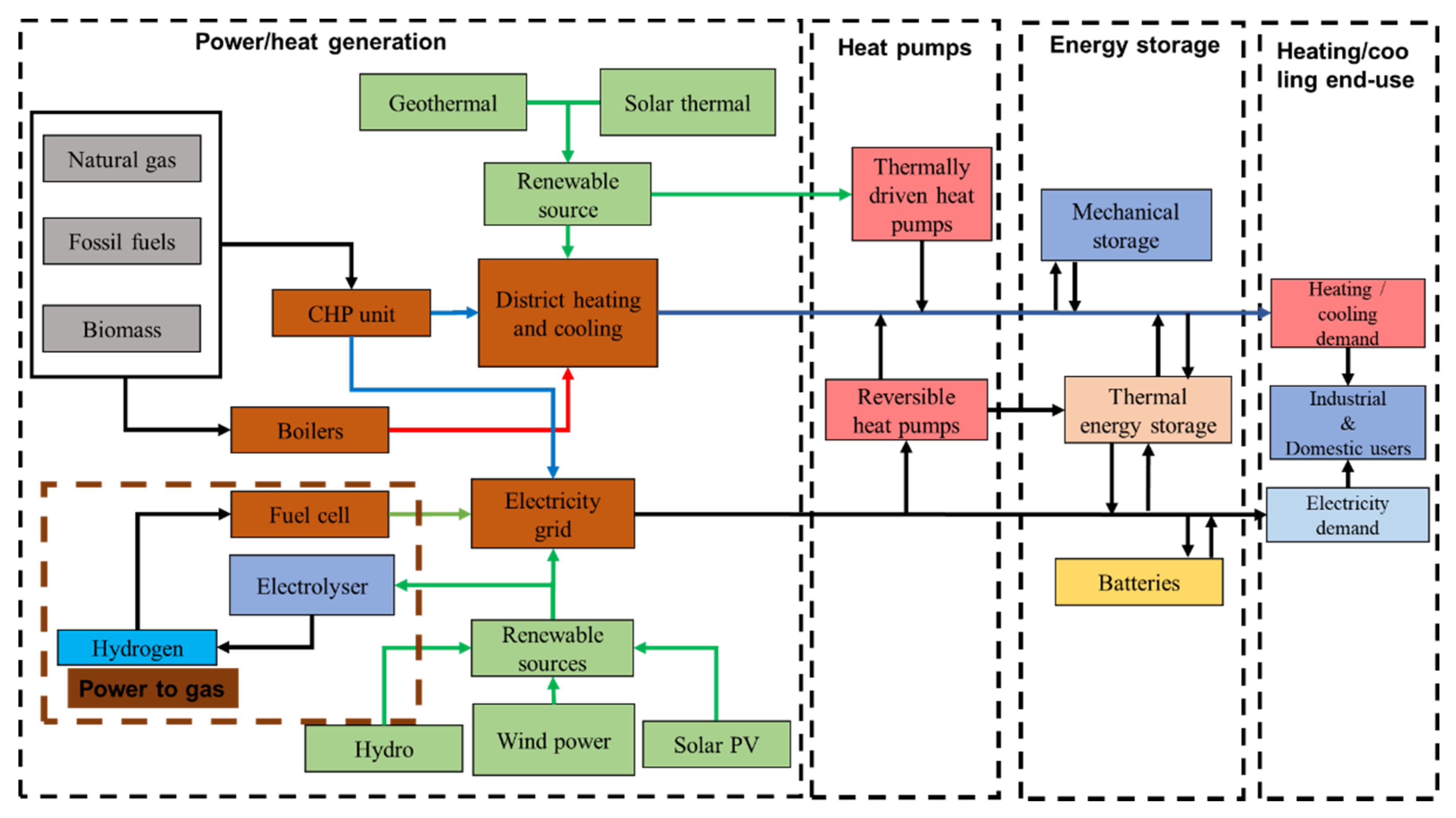
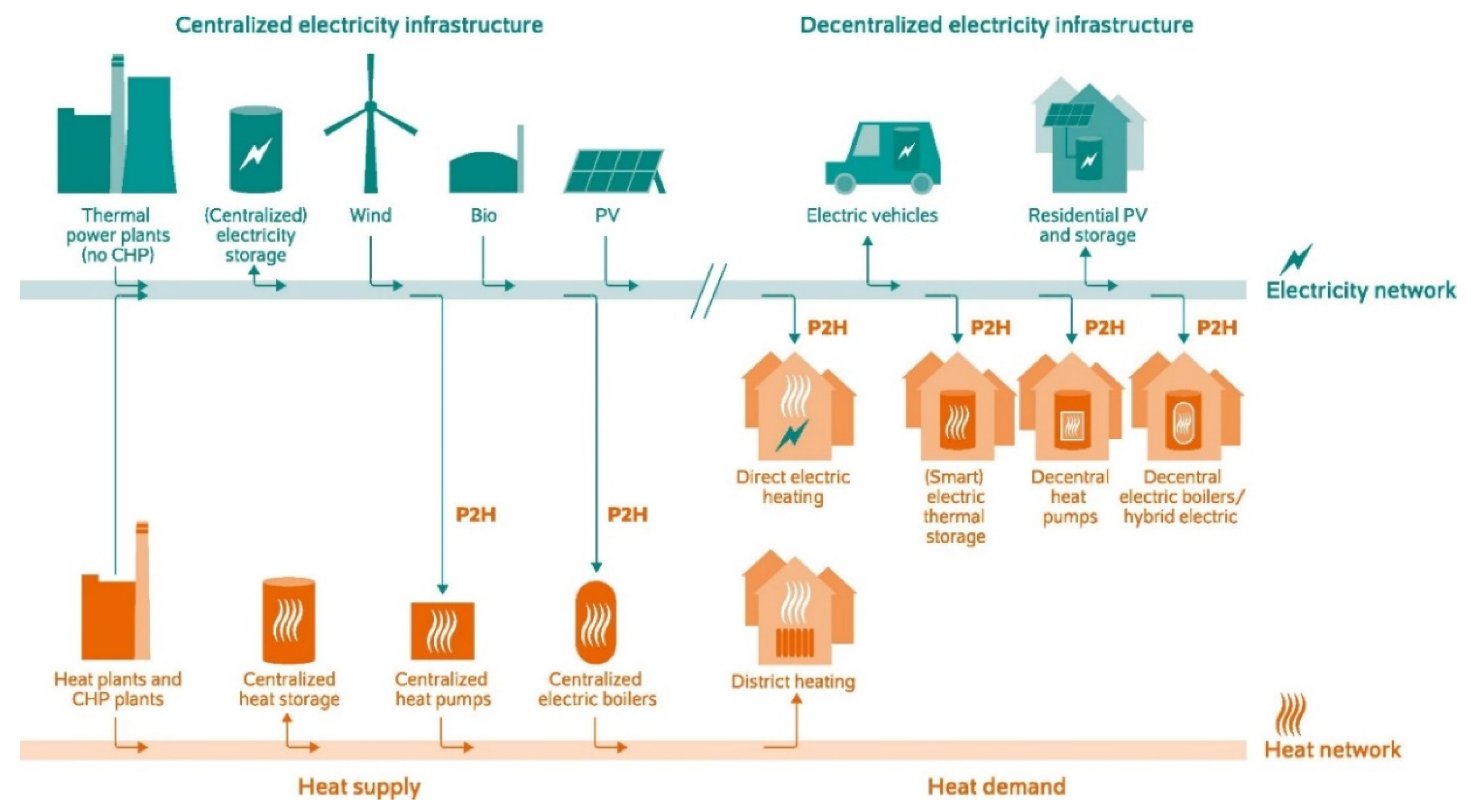

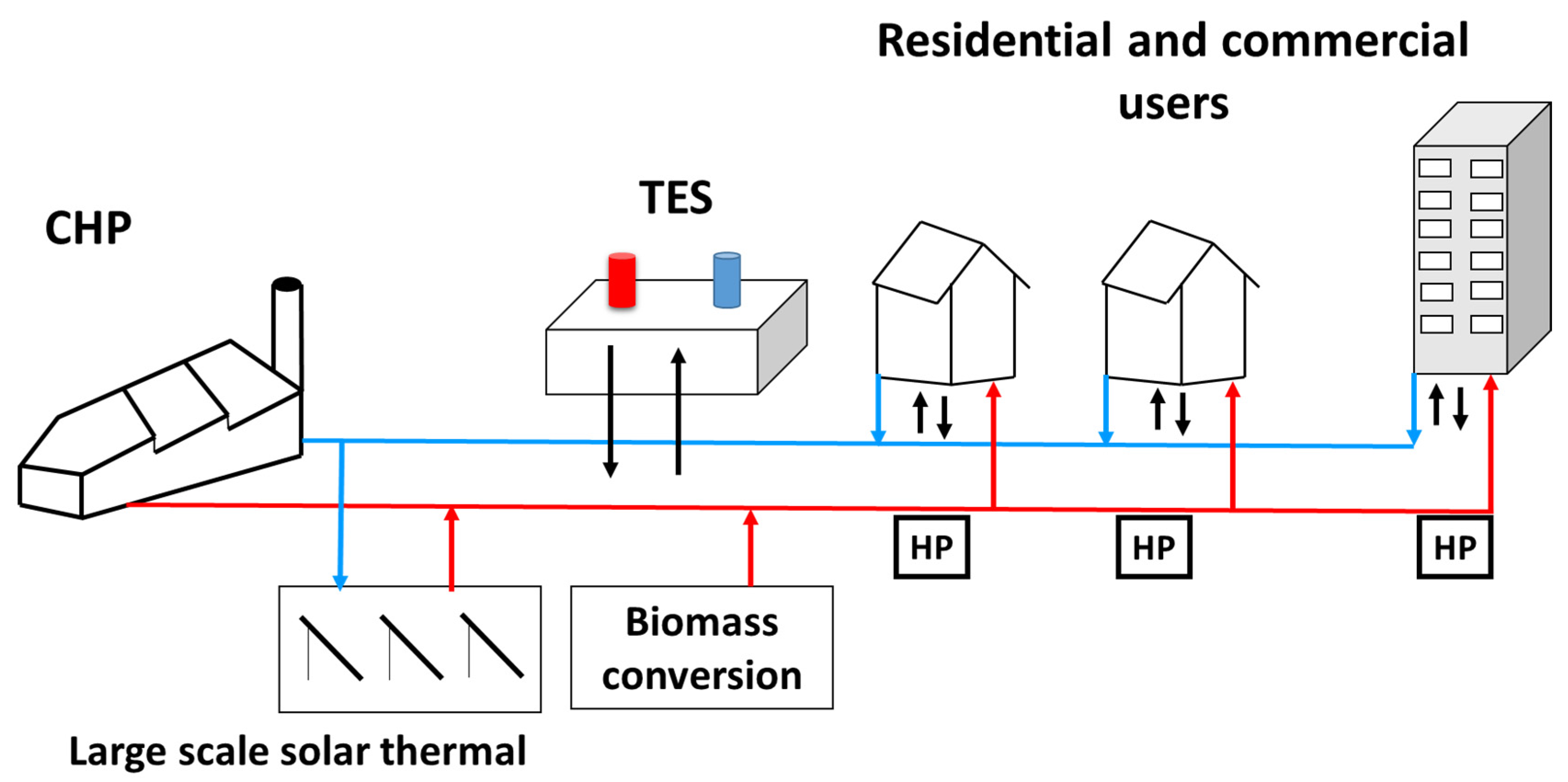
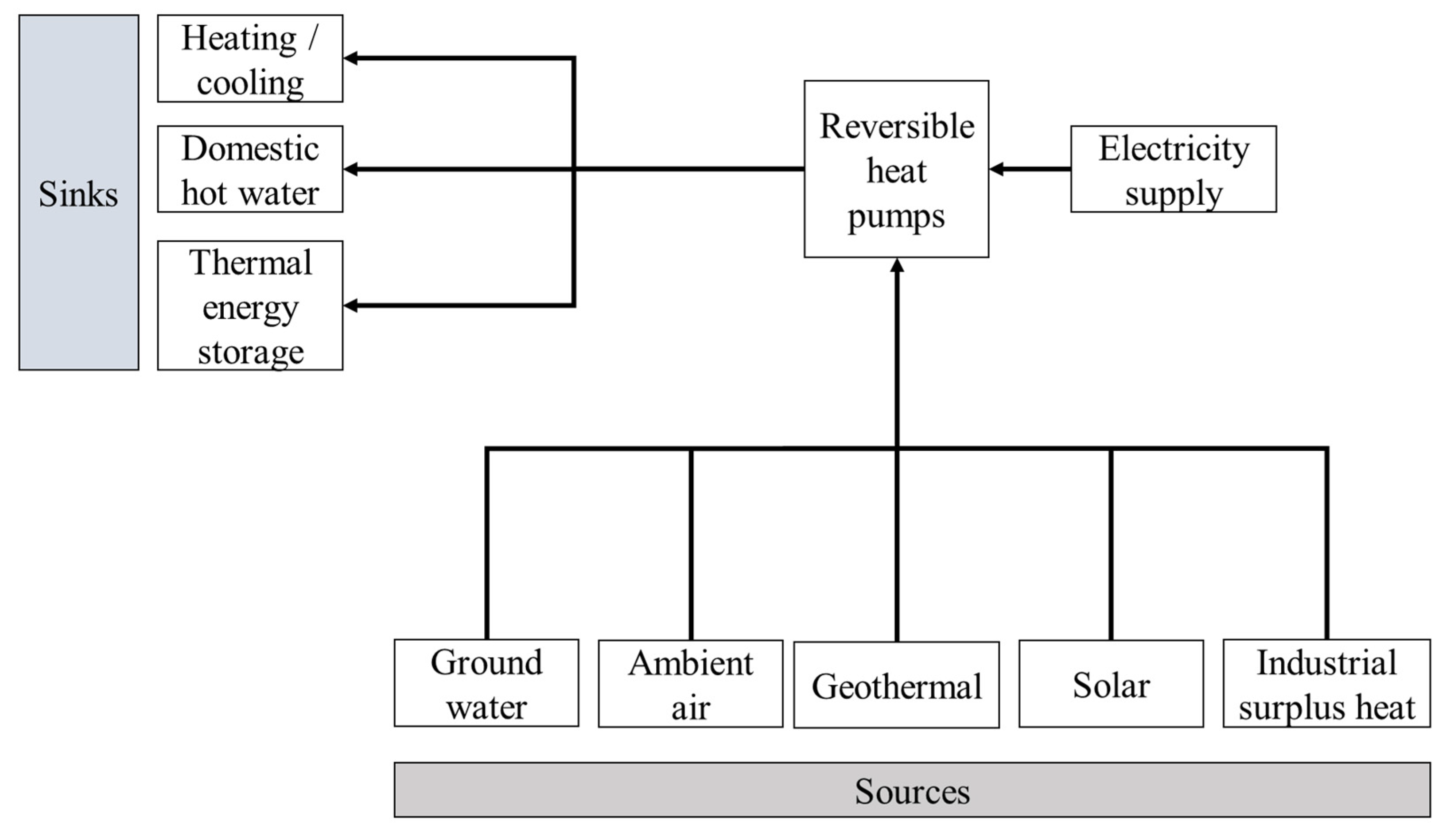

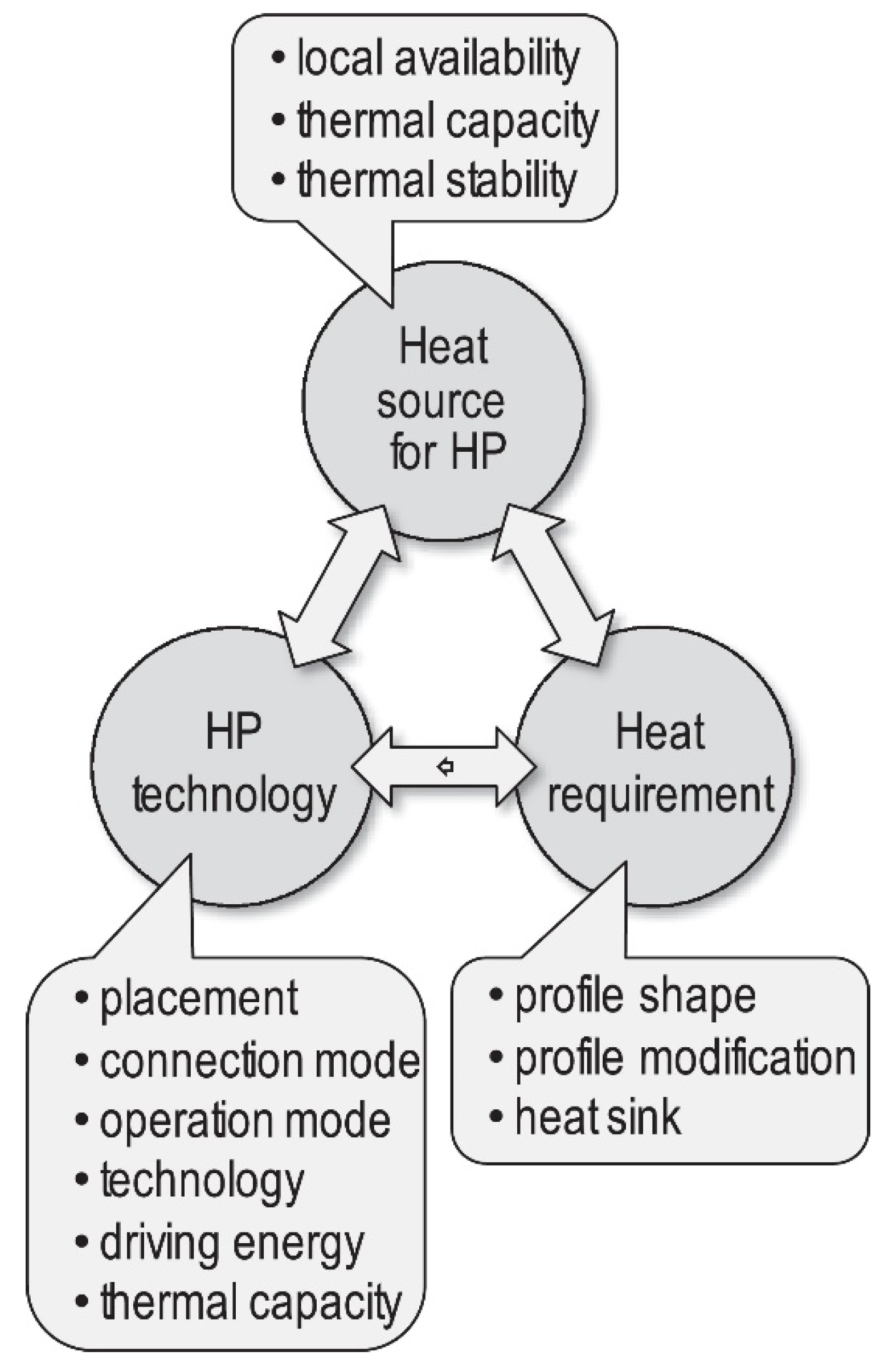

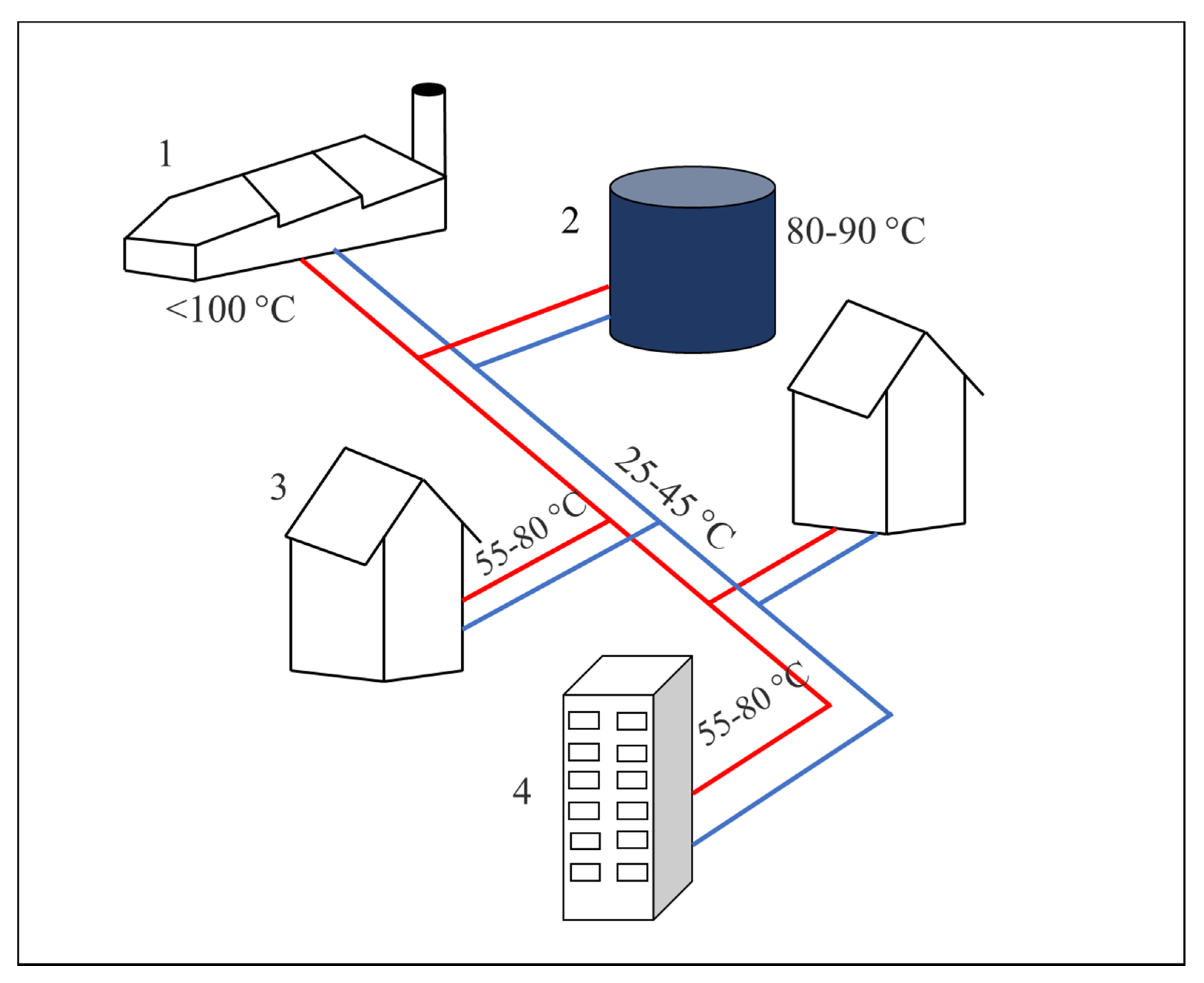
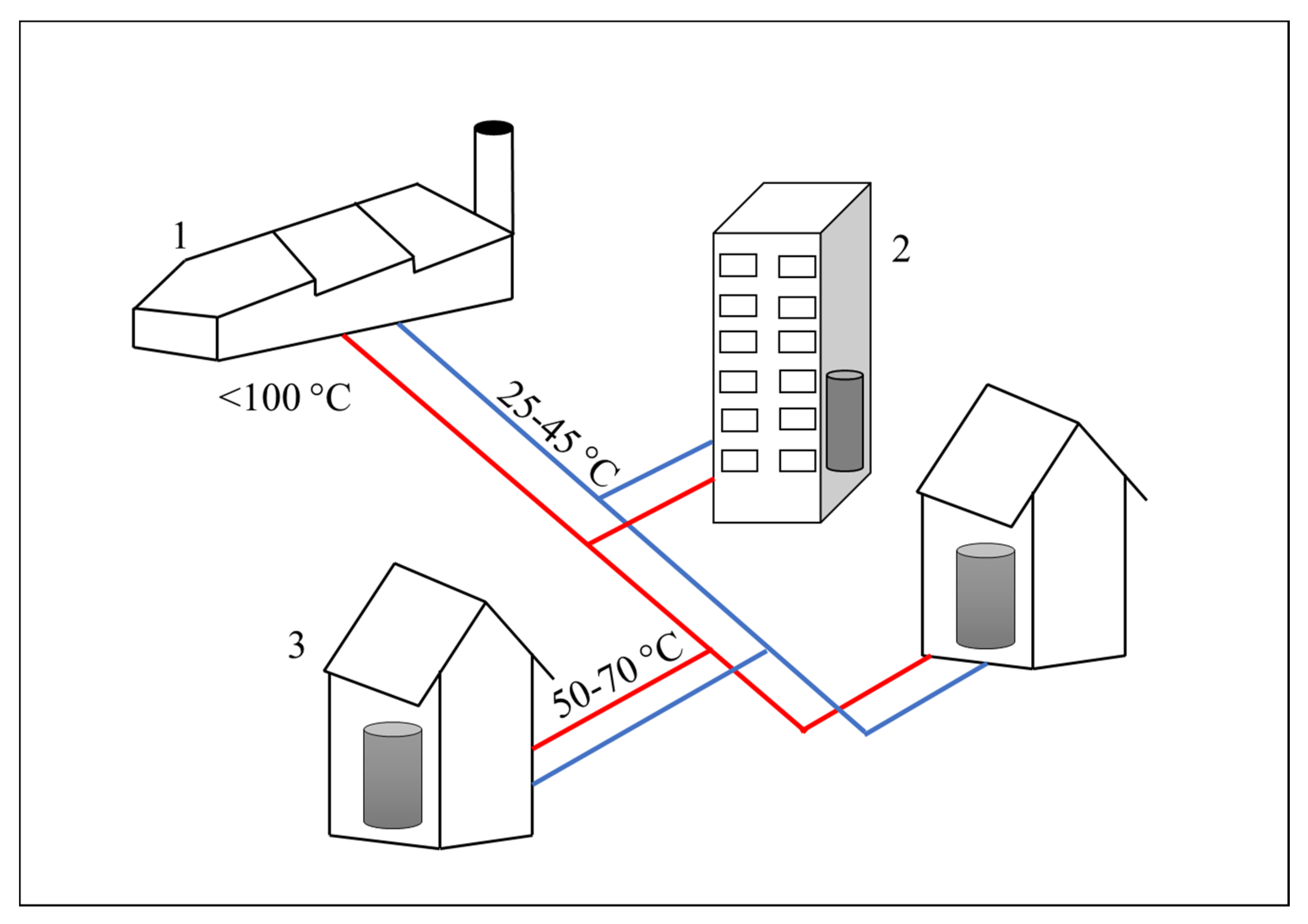
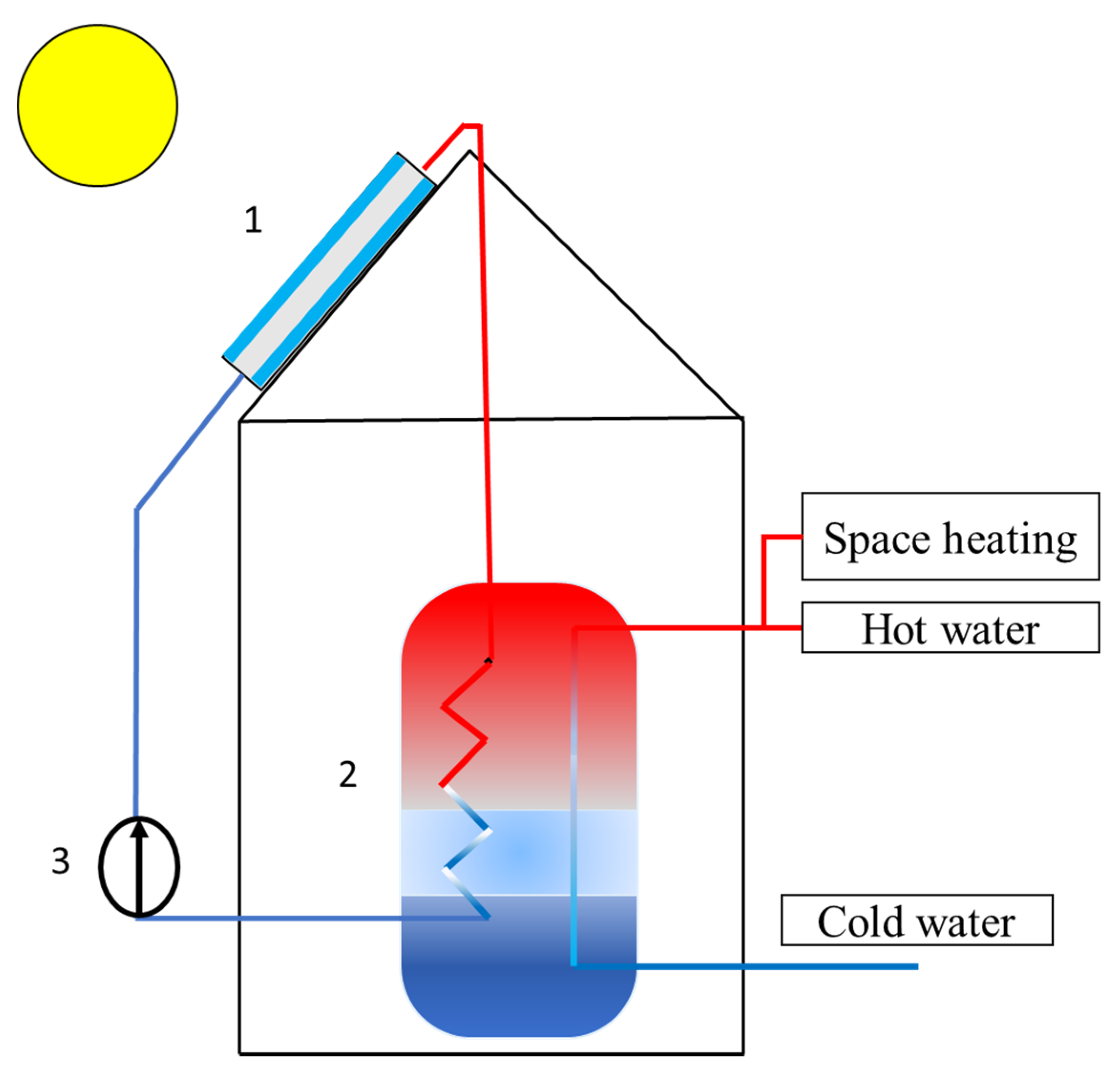



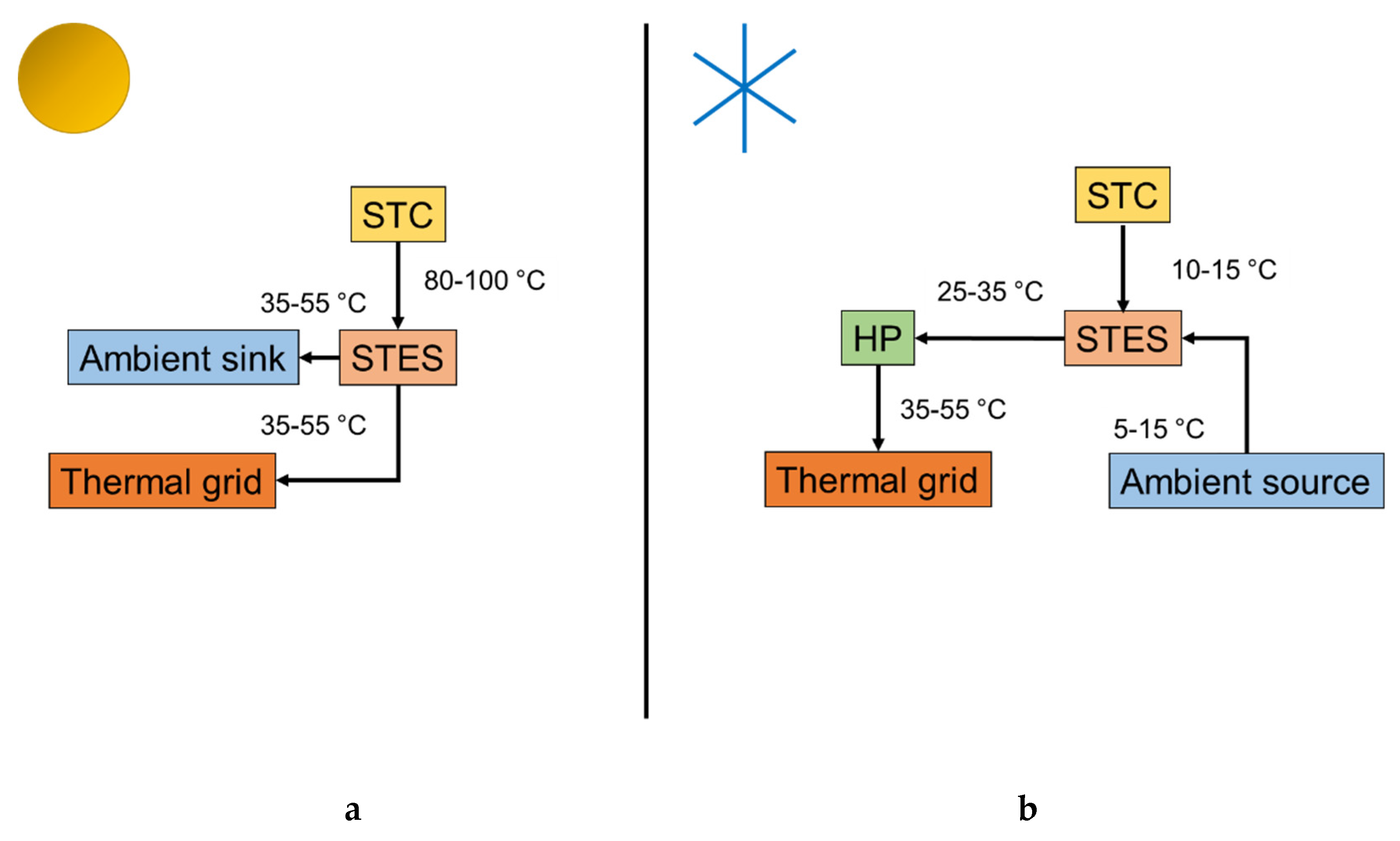
| Features | 1st Generation | 2nd Generation | 3rd Generation | 4th Generation | 5th Generation |
|---|---|---|---|---|---|
| Temperature | >200 °C [11] | >100 °C [11] | <100 °C [11] | 45–60 °C [11] | Region dependent, close to ambient temperature (10–30 °C) |
| Energy sources | Coal-fired boilers, CHP [39] | Coal- and oil-based CHP [39] | Biomass, waste or fossil fuel boilers, CHP [39] | Solar PV, wind energy, low-temperature recycling [39] | High penetration of RES, heat pumps, industrial surplus heat [39] |
| Renewable energy sources | No | No | Yes | Yes | Yes |
| Simultaneous provision of heating and cooling | No | No | No | No | Yes |
| Centralized/ Decentralized | Centralized | Centralized | Centralized | Partially decentralized | Highly decentralized |
| Heat carrier | Steam [11] | Pressurized water [11] | Pressurized water [11] | Low-temperature water [11] | Ultra-low-temperature water |
| Prosumers | No | No | No | Yes | Yes |
| Period of available technology | 1880–1930 [39] | 1930–1980 [39] | 1980–2020 [39] | 2020–2050 [39] | In research phase |
| Thermal losses | High | High | Medium | Low | Very low |
| Exergy losses | High | High | Medium | Low | Very low |
| Thermal storage | No | No | No | Yes | Yes |
| Application | Aim | Findings | References |
|---|---|---|---|
| Ancillary services for grid | Voltage control | Voltage problems can be reduced with the appropriate controlling strategies of HP. | [44,45,46,47,48,49,50,51,52,59,68,69,70,71] |
| Congestion management | Grid reinforcement can be reduced. Control strategies can reduce peaks but not in all cases. HP operation shows strong seasonal dependency for grid services. | ||
| Balancing generation demand and frequency regulation | Pools of HP can be used. On-field examples are limited. | ||
| Integration of RES | PV | Self-consumption increases with the use of variable speed HP. Seasonal inconsistency affects self-consumption. Feed-in peaks at noon can be reduced. | [30,53,54,55,56,57] |
| Wind | Wind integration reduces carbon emissions. It also helps in reducing fluctuations and peaks. Use of grid electricity can be reduced with local wind turbines. | ||
| Price-driven operation | Fluctuating electricity prices | More focus on decentralized control. Significant load shifting reported using price signals. Negative effect on efficiency reported. | [31,43,58,61,62,63,64,65,66,67] |
Publisher’s Note: MDPI stays neutral with regard to jurisdictional claims in published maps and institutional affiliations. |
© 2021 by the authors. Licensee MDPI, Basel, Switzerland. This article is an open access article distributed under the terms and conditions of the Creative Commons Attribution (CC BY) license (https://creativecommons.org/licenses/by/4.0/).
Share and Cite
Abdur Rehman, O.; Palomba, V.; Frazzica, A.; Cabeza, L.F. Enabling Technologies for Sector Coupling: A Review on the Role of Heat Pumps and Thermal Energy Storage. Energies 2021, 14, 8195. https://doi.org/10.3390/en14248195
Abdur Rehman O, Palomba V, Frazzica A, Cabeza LF. Enabling Technologies for Sector Coupling: A Review on the Role of Heat Pumps and Thermal Energy Storage. Energies. 2021; 14(24):8195. https://doi.org/10.3390/en14248195
Chicago/Turabian StyleAbdur Rehman, Omais, Valeria Palomba, Andrea Frazzica, and Luisa F. Cabeza. 2021. "Enabling Technologies for Sector Coupling: A Review on the Role of Heat Pumps and Thermal Energy Storage" Energies 14, no. 24: 8195. https://doi.org/10.3390/en14248195
APA StyleAbdur Rehman, O., Palomba, V., Frazzica, A., & Cabeza, L. F. (2021). Enabling Technologies for Sector Coupling: A Review on the Role of Heat Pumps and Thermal Energy Storage. Energies, 14(24), 8195. https://doi.org/10.3390/en14248195









